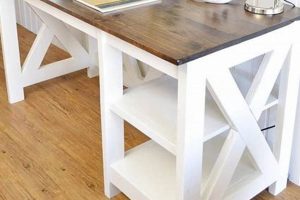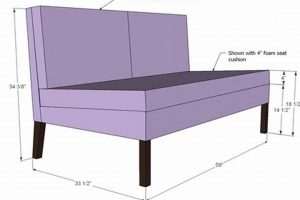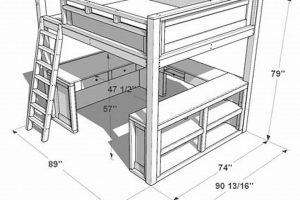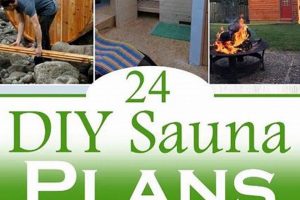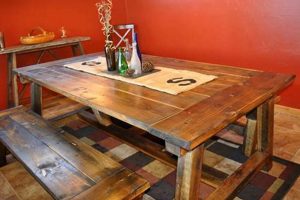The concept involves blueprints and instructions for constructing a baby bed at home, typically utilizing woodworking skills and readily available materials. These resources provide guidance on building a safe and functional sleeping space for infants, often customized to fit specific needs or aesthetic preferences. An example would be a detailed set of instructions outlining the cuts, assembly steps, and safety considerations for building a standard-size crib from lumber and hardware.
Constructing a baby bed offers potential cost savings compared to purchasing a commercially manufactured product. Furthermore, the practice enables greater control over material selection, allowing for the use of sustainable or non-toxic options. Historically, building furniture at home was a common practice, and these resources revive this tradition, fostering a sense of accomplishment and personalization in preparing for a new child. The ability to tailor the design to a specific nursery theme or space constraint provides an additional advantage.
The following sections will examine safety standards, material selection, construction techniques, and regulatory considerations relevant to building a safe and reliable infant sleeping structure. The goal is to provide thorough information to empower informed decisions throughout the construction process.
Construction Advice for Infant Bed Projects
The following recommendations are intended to aid in the creation of a safe and structurally sound infant bed. Adherence to these points is crucial for ensuring the well-being of the child.
Tip 1: Verify Compliance with Safety Standards: Ensure the design adheres to current safety standards established by regulatory bodies. This includes slat spacing, corner post height, and overall structural integrity. Example: Confirm that slat spacing does not exceed 2 3/8 inches (6 cm) to prevent entrapment.
Tip 2: Employ Non-Toxic Materials: Utilize lumber, finishes, and adhesives that are certified as non-toxic and safe for infant contact. This minimizes the risk of chemical exposure. Example: Select paints and varnishes labeled as “zero-VOC” (volatile organic compounds).
Tip 3: Secure Hardware Selection: Choose high-quality hardware, such as bolts and screws, designed to withstand stress and prevent loosening over time. Regular inspection and tightening are essential. Example: Use locking nuts and washers to prevent bolts from vibrating loose.
Tip 4: Prioritize Structural Integrity: Design the bed with robust joinery techniques to ensure stability and prevent collapse. Reinforce joints with glue and mechanical fasteners. Example: Employ mortise and tenon joints for maximum strength and durability.
Tip 5: Thoroughly Sand All Surfaces: Sand all surfaces smooth to eliminate sharp edges, splinters, and potential hazards. Pay particular attention to corners and edges. Example: Use progressively finer grits of sandpaper, finishing with at least 220-grit.
Tip 6: Conduct Rigorous Testing: Before use, test the bed for stability, weight capacity, and structural weaknesses. Apply pressure to all sides and corners to identify potential issues. Example: Simulate the weight of an infant and observe for any signs of stress or deformation.
Tip 7: Consult Expert Advice: Seek guidance from experienced woodworkers or engineers regarding structural design and safety considerations. Professional consultation can identify potential flaws in the design. Example: Share the plans with a qualified individual for review and feedback before commencing construction.
Adhering to these suggestions will contribute significantly to the creation of a secure and reliable sleeping environment for the infant. Diligence in the design and construction phases is paramount.
The subsequent sections will further elaborate on specific aspects of building process, ultimately providing complete understanding.
1. Safety compliance verification
Safety compliance verification constitutes a critical component of any effort involving plans for constructing a baby bed. The act of building an infant bed introduces potential hazards that are mitigated through adherence to established safety standards. These standards, often mandated by regulatory bodies, dictate specific dimensions, material requirements, and construction techniques designed to minimize risks such as entrapment, suffocation, and structural failure. For instance, slat spacing regulations are designed to prevent an infant’s limb from becoming trapped, potentially causing injury. Failure to verify compliance with these standards during the planning and execution phases increases the likelihood of creating an unsafe sleeping environment.
The practical application of safety compliance verification involves a multi-faceted approach. Initially, the builder must thoroughly research and understand the applicable safety standards in their jurisdiction. This includes regulations pertaining to slat spacing, mattress support, corner post height, and the use of non-toxic materials. Subsequently, the plans must be meticulously reviewed to ensure they align with these standards. During construction, constant vigilance is required to confirm that the actual dimensions and techniques employed match those specified in the plans and dictated by safety regulations. For example, if the plans call for a specific type of fastener, substituting a weaker alternative compromises the structural integrity and violates safety protocols. Post-construction, a comprehensive inspection should be conducted to identify any deviations from the standards or potential hazards that may have been overlooked.
In summary, safety compliance verification is not merely a recommended practice but a fundamental necessity when pursuing do-it-yourself infant bed construction. Its importance stems from the direct impact it has on the child’s safety and well-being. Neglecting this aspect introduces unacceptable risks. Therefore, thorough research, meticulous planning, diligent execution, and comprehensive inspection are crucial steps in ensuring that the completed project provides a safe and secure sleeping environment, aligning with both regulatory requirements and the ethical responsibility of ensuring child safety.
2. Material toxicity assessment
Material toxicity assessment, within the context of constructing a baby bed, represents a critical evaluation of the potential health risks associated with the substances employed in the project. Plans for constructing a baby bed often prioritize structural integrity and aesthetic appeal; however, the chemical composition of the materials constitutes an equally vital consideration. Infants are particularly vulnerable to the adverse effects of toxic substances due to their developing organ systems and increased exposure pathways, such as mouthing surfaces. Therefore, a comprehensive evaluation of material toxicity is imperative to mitigate potential health hazards.
The interconnection between material toxicity assessment and plans for constructing a baby bed manifests in several practical ways. For example, a seemingly harmless wood finish may contain volatile organic compounds (VOCs) that off-gas into the surrounding environment, leading to respiratory irritation or other health issues. Similarly, certain adhesives used in joinery may release formaldehyde, a known carcinogen. The selection of lumber itself is relevant, as some treated woods contain preservatives that are not safe for infant exposure. Therefore, careful consideration must be given to the composition of paints, varnishes, adhesives, and even the wood itself. Informed decision-making requires consulting safety data sheets (SDS) and seeking materials certified as low-VOC or non-toxic. Ignoring this assessment can result in long-term health consequences for the infant. A practical understanding of material toxicity assessment dictates the selection of alternative materials, such as water-based finishes and formaldehyde-free adhesives, thereby minimizing the potential for harmful exposure.
In conclusion, the integration of material toxicity assessment within the conceptual framework of plans for constructing a baby bed is indispensable for safeguarding infant health. The challenge lies in the necessity for builders to acquire sufficient knowledge regarding the chemical properties of various materials and their potential health implications. While plans may provide instructions on assembly and design, the responsibility for selecting safe and appropriate materials rests squarely upon the builder. By prioritizing material toxicity assessment, a safer sleeping environment can be created, ensuring the well-being of the infant.
3. Structural design robustness
Structural design robustness, in the context of “diy crib plans,” refers to the ability of the crib to withstand anticipated loads and stresses without failure. This characteristic is of paramount importance. A structurally deficient crib poses a direct and immediate threat to the infant’s safety. The consequence of design flaws or inadequate construction can range from minor discomfort to catastrophic collapse, resulting in serious injury or death. Cause-and-effect relationships are readily apparent: inadequate joint strength leads to component separation; insufficient material thickness results in deflection or breakage under load; and unstable configurations contribute to tipping hazards. The presence of robust structural design inherently reduces these risks, providing a safer sleeping environment.
The significance of structural design robustness is further underscored by real-life examples. Recalls of commercially manufactured cribs often stem from failures in structural integrity, such as collapsing sides or detaching components. These incidents highlight the criticality of a well-engineered design and meticulous execution. Within the realm of “diy crib plans,” the responsibility for ensuring structural integrity rests entirely with the builder. This entails selecting appropriate materials, employing robust joinery techniques, and accurately calculating load-bearing capacity. A lack of expertise or a disregard for engineering principles can easily compromise the structural integrity of the finished product. Consequently, builders must either possess sufficient knowledge or seek professional guidance to validate their designs.
In conclusion, structural design robustness constitutes a non-negotiable component of “diy crib plans.” Its absence directly translates to an elevated risk of infant injury. The practical significance of understanding and implementing sound engineering principles cannot be overstated. While aesthetic considerations are important, they must never supersede the fundamental requirement of ensuring a structurally sound and safe sleeping environment. Competent design, material selection, and construction techniques are essential for mitigating the potential hazards associated with constructing a baby bed.
4. Hardware fastening integrity
Hardware fastening integrity, within the framework of “diy crib plans,” directly pertains to the reliability and strength of the connections created using mechanical fasteners such as screws, bolts, and nails. The secure joining of components is crucial for the overall stability and safety of the infant bed. A failure in fastening integrity can lead to the loosening or detachment of parts, creating hazardous gaps or structural instability. The absence of robust fastening directly increases the risk of crib collapse or component failure, potentially resulting in infant injury or fatality.
The correlation between “Hardware fastening integrity” and “diy crib plans” is demonstrably evident in real-world examples. Crib recalls frequently cite issues related to hardware failure, such as screws stripping from wood or bolts loosening due to inadequate locking mechanisms. These incidents highlight the importance of selecting appropriate hardware types and sizes, employing correct installation techniques, and utilizing supplementary measures like thread-locking compounds. For instance, using screws that are too short or driving them into pre-drilled holes that are too large will compromise the holding power. Similarly, failing to properly tighten bolts or neglecting to use lock washers can lead to gradual loosening over time. Plans must specify appropriate hardware, provide clear instructions for installation, and emphasize the need for regular inspection and maintenance.
In summation, the importance of hardware fastening integrity in the context of “diy crib plans” cannot be overstated. The structural soundness of the crib hinges on the reliable performance of its mechanical fasteners. Builders must prioritize the selection of high-quality hardware, adhere to recommended installation procedures, and implement preventative measures to ensure long-term stability. Overlooking this aspect introduces unacceptable risks, undermining the overall safety and functionality of the infant bed. The understanding and diligent application of proper fastening techniques are essential for responsible crib construction.
5. Finishing smoothness
Finishing smoothness, within the context of plans for a do-it-yourself infant bed, refers to the tactile quality of all exposed surfaces of the constructed piece. This parameter is crucial not merely for aesthetic reasons, but primarily for safety and hygiene. A rough or uneven surface poses a direct threat to the infant, increasing the risk of splinters, scratches, and skin irritation. The presence of sharp edges or protruding imperfections can lead to cuts or abrasions, particularly as the infant begins to explore the environment by touch. Inadequate finishing also creates an environment conducive to the accumulation of dust, dirt, and bacteria, potentially compromising the infant’s health. Therefore, achieving optimal smoothness is an essential aspect of constructing a safe and sanitary sleeping space.
The significance of finishing smoothness is substantiated by numerous practical examples. Commercially manufactured cribs undergo rigorous finishing processes to ensure a uniform and non-abrasive surface. Regulatory standards often specify minimum smoothness requirements to minimize potential hazards. Consider a scenario where a crib slat is not properly sanded, leaving exposed wood fibers. These fibers can easily detach, becoming lodged in the infant’s skin or ingested, leading to discomfort or infection. Similarly, a poorly applied finish can chip or flake, creating sharp edges and introducing potentially toxic particles into the infant’s environment. The application of multiple coats of a non-toxic finish, followed by fine sanding between coats, is a standard procedure for achieving a smooth and durable surface. Such attention to detail is not merely cosmetic; it is a fundamental safety measure.
In conclusion, the attainment of finishing smoothness constitutes a non-negotiable element of safe and responsible do-it-yourself infant bed construction. Its importance transcends mere aesthetics, directly impacting the infant’s health and well-being. Diligent sanding, proper finish application, and rigorous inspection are essential steps in mitigating the risks associated with rough or uneven surfaces. Overlooking this aspect introduces preventable hazards that compromise the safety and usability of the finished product. Therefore, meticulous attention to detail in achieving optimal finishing smoothness is paramount.
6. Testing thoroughness
Testing thoroughness, within the context of self-constructed infant beds, is the exhaustive evaluation of the finished product to identify potential safety hazards and structural weaknesses. This process transcends mere visual inspection, requiring the application of specific procedures to simulate real-world use conditions and expose latent defects. Insufficient testing introduces unacceptable risks to the infant, as undetected flaws can lead to component failure or injury.
- Structural Load Testing
Structural load testing involves applying static and dynamic loads to the crib to assess its ability to withstand weight and movement. This includes simulating the weight of the infant, bedding, and potential external forces. For example, applying a specified weight to the mattress and observing for excessive deflection or signs of stress. Commercially manufactured cribs are subjected to rigorous load testing to ensure compliance with safety standards. In the context of “diy crib plans,” builders must implement similar testing protocols to validate their designs and construction techniques. Failure to adequately test the load-bearing capacity can result in catastrophic structural failure during use.
- Hardware Integrity Assessment
Hardware integrity assessment focuses on the fasteners and joints that connect the crib’s components. This involves visually inspecting and physically testing the tightness and security of all screws, bolts, and other hardware. For instance, torque testing bolts to verify they are tightened to the manufacturer’s specifications and examining screws for signs of stripping or loosening. Crib recalls often cite hardware failures as a contributing factor to safety hazards. For “diy crib plans,” builders must implement robust testing procedures to identify and rectify any hardware deficiencies. Neglecting this assessment can lead to component separation and potential entrapment hazards.
- Stability and Tip-Over Resistance Evaluation
Stability and tip-over resistance evaluation examines the crib’s propensity to tip or overturn under normal use conditions. This involves applying lateral forces to the crib and observing its stability. Example: Pushing on the side of the crib to determine if it can be easily tipped. Lack of stability poses a significant risk to the infant. Commercial cribs are designed to resist tipping, and similar consideration must be given in DIY construction. Failure to adequately assess stability can result in the crib tipping over, causing injury to the infant.
- Entrapment Hazard Inspection
Entrapment hazard inspection involves meticulously examining the crib for any openings or gaps that could pose a risk of infant entrapment. This includes measuring slat spacing, corner post extensions, and any other potential entrapment points. Regulations specify maximum allowable dimensions for these features. “diy crib plans” must incorporate designs that adhere to these specifications. Failure to thoroughly inspect for entrapment hazards can lead to serious injury or suffocation.
The integration of thorough testing protocols within the framework of “diy crib plans” is essential for ensuring the safety and reliability of the finished product. These testing facets, when applied diligently, mitigate the risks associated with self-constructed infant beds. By subjecting the crib to rigorous evaluations, builders can identify and address potential flaws, ultimately creating a safer sleeping environment for the infant.
Frequently Asked Questions
The following questions address common concerns regarding the design, construction, and safety of infant beds built from independently sourced plans.
Question 1: What are the primary safety standards that must be adhered to when constructing an infant bed?
Slat spacing should not exceed 2 3/8 inches (6 cm) to prevent limb entrapment. Corner posts must not extend more than 1/16 inch above the end panels to prevent clothing entanglement. The bed’s structure must withstand static and dynamic loads equivalent to typical infant activity without deformation or failure. All materials must be non-toxic and compliant with relevant regulatory standards.
Question 2: What materials are recommended for building a safe and durable infant bed?
Solid hardwoods, such as maple, oak, or birch, are preferred for their strength and stability. Avoid softwoods like pine or cedar, which are more prone to splintering and damage. Use formaldehyde-free plywood for panels. Finishes should be low-VOC or non-toxic, specifically formulated for infant furniture. Hardware must be high-quality steel with locking mechanisms.
Question 3: How can structural integrity be assured during the construction process?
Employ robust joinery techniques, such as mortise and tenon or dovetail joints, for maximum strength. Reinforce joints with high-quality wood glue and mechanical fasteners. Ensure all components are accurately measured and precisely cut to minimize gaps and stress points. Conduct load testing during and after assembly to identify any structural weaknesses.
Question 4: What types of finishes should be avoided due to potential toxicity?
Avoid oil-based paints and varnishes, which typically contain high levels of volatile organic compounds (VOCs). Refrain from using lead-based paints or finishes containing heavy metals. Do not apply polyurethane finishes directly to surfaces that the infant may contact, as they can off-gas for an extended period. Select water-based or plant-based finishes certified as non-toxic and safe for infant use.
Question 5: How often should a self-constructed infant bed be inspected for potential safety hazards?
A thorough inspection should be conducted before initial use and at least monthly thereafter. Check for loose hardware, cracked or splintered wood, and any signs of structural weakening. Verify that slat spacing remains within acceptable limits and that the mattress fits snugly within the frame. Promptly address any identified issues to prevent potential hazards.
Question 6: What recourse is available if a self-constructed infant bed is found to be unsafe?
If the bed exhibits any safety defects, discontinue its use immediately. Consult with an experienced woodworker or engineer to assess the structural integrity and identify potential remedies. Depending on the severity of the issues, the bed may require significant modifications or complete disassembly. The safety of the infant is the paramount concern.
Prioritizing safety through meticulous planning, material selection, and construction techniques is paramount. Regular inspections and proactive maintenance are essential for ensuring the long-term integrity of the structure.
The subsequent section will address potential modifications and customization options.
Conclusion
The preceding discussion has detailed critical considerations pertaining to plans for creating a baby bed. This examination encompassed safety standards, material assessment, structural integrity, hardware reliability, finishing quality, and the necessity of thorough testing. Emphasis was placed on the builder’s responsibility to ensure the completed structure provides a secure environment for the child.
The complexity inherent in independently constructing an infant bed necessitates careful deliberation. Given the potential consequences of design or construction flaws, builders must exercise due diligence in adherence to safety guidelines and the implementation of sound engineering principles. Prioritizing child safety constitutes the ethical imperative guiding all stages of the process.


